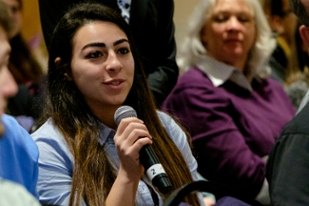The growing size of data on the Constitution
NewsSUMMARY: In the time Hu spent in Washington D.C. following the events of Sept. 11, she observed the bureaucratic structure and technology needed to support what she felt at that time to be a nation focused on surveillance.
As the average American increases his digital footprint through email, calls and social media, and as the government is able to increase its data storage, a question of privacy and the reach of the constitution arises. At the most recent Madison Vision Series presentation Margaret Hu discusses technology, the role it can play in our governing structure, and how the Constitution holds up to these advancements.
Hu, an assistant professor of law at Washington and Lee University, then challenged attendees to contemplate the “rise of the cybersurveillance state” and the ways in which the United State’s ever-growing data production and storage practices impact the major topics of our day - immigration, national security and personal liberties.
In the time Hu spent in Washington D.C. following the events of Sept. 11, she observed the bureaucratic structure and technology needed to support what she felt at that time to be a nation focused on surveillance. She noted the ways in which the technology embedded in Americans day-to-day activity was used as a means to govern in the interest of national security.
Since then, Hu argues that an evolution in how the government uses technology has occurred. She made the assertion, that as a country, we are making a jump from a national surveillance state to a cybersurveillance state as the result of recent technological advances that allow humans to store trillions of gigabytes of data. She laid out our future as a “big data” nation where the government seeks to collect as much information as possible in hopes of predicting and solving future problems.
This is “flipping the world upside down,” says Hu. Up to this point she claims we have existed in “small data” world, where small data was physical, analog data that was curated and filed. By nature, data had to follow a specific question instead of a blanket collection scheme because there was not enough space. Now, given the available storage space, Hu asserts that the systems of data collection are changing faster than a process or a structure can be put in place.

She framed the consequences of this growing system by explaining that with the new “collect it all” mantra, everyone, or rather everyone’s digital avatar is a target. She feels there are no longer suspicious people, but suspicious data.
To explain, she cited the “no-fly list,” as an example of a flawed process and output built on suspicious data. She argues that the accused do not know why they are placed on the no-fly list, and because that information is classified, their lawyers cannot defend them and they cannot be removed. She warns of the danger of what she sees as procedure less lists.
Hu questioned the constitutionality of these types of projects, calling for scientific verification of data and the expansion of the Fourth Amendment. This expansion, she believes, would aid in prohibiting unreasonable search and seizure. Another option, she explains, is to make the technology smaller by limiting what the government can do with technology.
In closing, she stressed that procedure needs to catch up with data collection technology to protect citizens from abuses. Hu encouraged the JMU community to continue to be “very deeply engaged in the process of democracy” by voting, reaching out to representatives and contributing to civic discourse. These practices, she believes, safeguards individuals rights, liberties and fundamental freedoms.
The next Madison Vision Series presentation features Dr. Sylvia Hurtado, professor at the Graduate School of Education and Information Studies, and Director of the Higher Education Research Institute at the University of California, Los Angelos, on March 17, from 3:30 to 5 p.m. at Grafton-Stovall Theatre.

